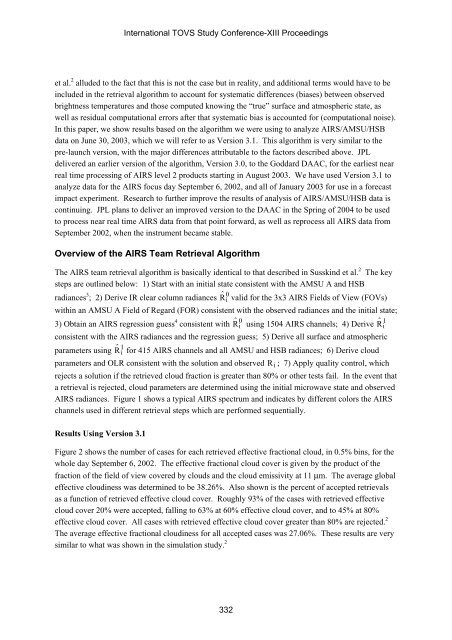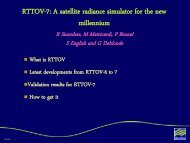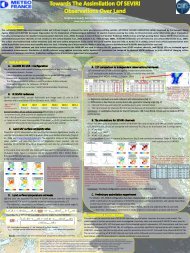Current results from AIRS/AMSU/HSB
Current results from AIRS/AMSU/HSB
Current results from AIRS/AMSU/HSB
You also want an ePaper? Increase the reach of your titles
YUMPU automatically turns print PDFs into web optimized ePapers that Google loves.
International TOVS Study Conference-XIII Proceedings<br />
et al. 2 alluded to the fact that this is not the case but in reality, and additional terms would have to be<br />
included in the retrieval algorithm to account for systematic differences (biases) between observed<br />
brightness temperatures and those computed knowing the “true” surface and atmospheric state, as<br />
well as residual computational errors after that systematic bias is accounted for (computational noise).<br />
In this paper, we show <strong>results</strong> based on the algorithm we were using to analyze <strong>AIRS</strong>/<strong>AMSU</strong>/<strong>HSB</strong><br />
data on June 30, 2003, which we will refer to as Version 3.1. This algorithm is very similar to the<br />
pre-launch version, with the major differences attributable to the factors described above. JPL<br />
delivered an earlier version of the algorithm, Version 3.0, to the Goddard DAAC, for the earliest near<br />
real time processing of <strong>AIRS</strong> level 2 products starting in August 2003. We have used Version 3.1 to<br />
analyze data for the <strong>AIRS</strong> focus day September 6, 2002, and all of January 2003 for use in a forecast<br />
impact experiment. Research to further improve the <strong>results</strong> of analysis of <strong>AIRS</strong>/<strong>AMSU</strong>/<strong>HSB</strong> data is<br />
continuing. JPL plans to deliver an improved version to the DAAC in the Spring of 2004 to be used<br />
to process near real time <strong>AIRS</strong> data <strong>from</strong> that point forward, as well as reprocess all <strong>AIRS</strong> data <strong>from</strong><br />
September 2002, when the instrument became stable.<br />
Overview of the <strong>AIRS</strong> Team Retrieval Algorithm<br />
The <strong>AIRS</strong> team retrieval algorithm is basically identical to that described in Susskind et al. 2 The key<br />
steps are outlined below: 1) Start with an initial state consistent with the <strong>AMSU</strong> A and <strong>HSB</strong><br />
radiances 3 ; 2) Derive IR clear column radiances ˆ 0<br />
R i valid for the 3x3 <strong>AIRS</strong> Fields of View (FOVs)<br />
within an <strong>AMSU</strong> A Field of Regard (FOR) consistent with the observed radiances and the initial state;<br />
3) Obtain an <strong>AIRS</strong> regression guess<br />
4 consistent with ˆ 0<br />
R i using 1504 <strong>AIRS</strong> channels; 4) Derive R ˆ 1 i<br />
consistent with the <strong>AIRS</strong> radiances and the regression guess; 5) Derive all surface and atmospheric<br />
parameters using ˆ 1<br />
R i for 415 <strong>AIRS</strong> channels and all <strong>AMSU</strong> and <strong>HSB</strong> radiances; 6) Derive cloud<br />
parameters and OLR consistent with the solution and observed R i ; 7) Apply quality control, which<br />
rejects a solution if the retrieved cloud fraction is greater than 80% or other tests fail. In the event that<br />
a retrieval is rejected, cloud parameters are determined using the initial microwave state and observed<br />
<strong>AIRS</strong> radiances. Figure 1 shows a typical <strong>AIRS</strong> spectrum and indicates by different colors the <strong>AIRS</strong><br />
channels used in different retrieval steps which are performed sequentially.<br />
Results Using Version 3.1<br />
Figure 2 shows the number of cases for each retrieved effective fractional cloud, in 0.5% bins, for the<br />
whole day September 6, 2002. The effective fractional cloud cover is given by the product of the<br />
fraction of the field of view covered by clouds and the cloud emissivity at 11 µm. The average global<br />
effective cloudiness was determined to be 38.26%. Also shown is the percent of accepted retrievals<br />
as a function of retrieved effective cloud cover. Roughly 93% of the cases with retrieved effective<br />
cloud cover 20% were accepted, falling to 63% at 60% effective cloud cover, and to 45% at 80%<br />
effective cloud cover. All cases with retrieved effective cloud cover greater than 80% are rejected. 2<br />
The average effective fractional cloudiness for all accepted cases was 27.06%. These <strong>results</strong> are very<br />
similar to what was shown in the simulation study. 2<br />
332








